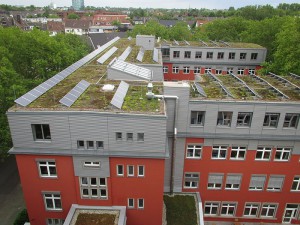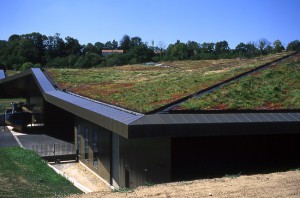Share This
Related Posts
Tags
Glorious Green Roofs
By Yardi Blog Staff on Jun 29, 2015 in Technology

Green roof and solar array atop GLS Bank, Bochum, Germany – credit: Molgreen via Wikimedia Commons
France, the epicenter of style and fashion, has recently dealt a blow to the detractors of solar panels and green roofs by passing legislation that will require all new commercial buildings to feature green roofs.
New buildings constructed in French commercial zones will have to be partially covered by either living foliage or solar panels, under the new law, which, albeit less drastic than its initial form (which would have applied to all buildings and the entire surface of roofs), will have a significant impact. Installing solar panels will obviously add green energy to France’s massive energy appetite. Green roofs will bring their own plethora of environmentally friendly features.
Higher costs –bigger returns
Green roofs significantly increase the insulation of a structure, thus decreasing the need for air conditioning and heating. According to a recent study by Universidad Politécnica de Madrid and Università Politecnica delle Marche researchers, roofs with dense vegetation are 60 percent more efficient than traditional roofs and can in fact act as passive cooling systems. Furthermore green roofs absorb less heat during the day than traditional roofs, thus lowering the heat island effect that plagues cities, especially large urban environments. This is further exacerbated by the fact that green roofs release less energy during the night than they absorb during the day.
Moreover, green roofs absorb a large quantity of rainwater, reducing runoff, decreasing the pressure put on city sewage systems, especially during large weather events. When local and/or drought-resistant flora is used for green roofs, there is little to no added water consumption. Green roofs also contribute to healthier environments by absorbing pollutants and releasing oxygen and providing shelter and nesting places for birds and small local fauna, contributing to local biodiversity. Green roofs can also be used as gardens to produce hyper-local food – a growing trend even U.S. cities, such as New York.

Green roof at l’Histoial de la Vendée, Les-Lucs-sur-Boulogne, France – credit: Simon Garbutt via Wikimedia Commons
A significant added bonus of green roofs is longevity and cost-effectiveness, despite its larger initial investment. A green roof can in fact prolong the lifespan of a traditional roof by upwards of 20 years. According to a U.S. General Services Administration cost-benefit analysis of green roofs versus black roofs, the internal rate of return for green roofs starts at 5 percent increases with the size of roof, while the return on investment starts at 220 percent and increases with square footage. In fact, it takes only 11 to 14 years to break even on green roof investments.
Popularity on the rise
Green roofs are not restricted to France. Switzerland’s capital of Basel has the largest quantity of green roofs per capita in the world. The City has been promoting green roofs since the ‘90s, with the first green roof incentive program running between 1996 and 1997 and followed by a second wave in 2005 and 2006. The incentives program was funded from Basel’s Energy Saving Fund, which was established by law in the early ‘90s to collect 5 percent of all customers’ energy bills. Basel building by-laws made green roofs mandatory since 2002 for all buildings, including multi-family structures and provisions are expected to increase.
Copenhagen also implemented green roof policies, which were made mandatory in 2010 for all new buildings with slopes below 30 degrees. In its race to become a carbon neutral city by 2025 and the first carbon-neutral capital, the city’s green roof law applies to both private and public new buildings and also incorporates old roof refurbishments.
Germany, the birthplace of the modern green roof in the ‘60s is the undoubted global green roof leader. While the number of green roofs varies by source, around 10 percent of German roofs are green, with green roof industry growing 10 to 15 percent annually a few years ago. As Germany adopts more and more aggressively green strategies, the growth rate is likely higher presently.
